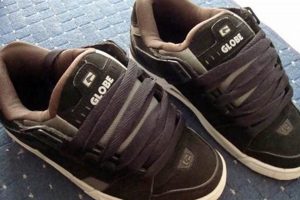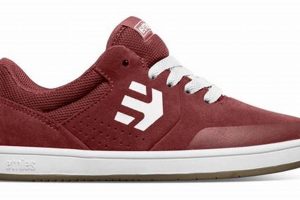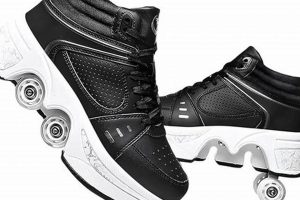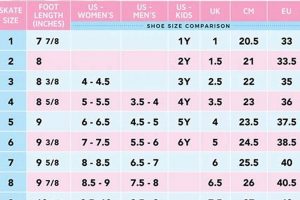Footprint skate shoes represent a specific brand of footwear designed for skateboarding. These shoes are engineered with a focus on impact protection and durability, catering to the demands of skateboarding activities. A typical example might include a low-profile shoe with reinforced stitching, a specialized insole for shock absorption, and a durable outsole to withstand abrasive surfaces.
The importance of this type of footwear stems from the need to protect feet from the high-impact landings and repetitive stress inherent in skateboarding. Benefits include enhanced comfort, reduced risk of injury, and improved board feel, all of which contribute to better performance and prolonged skating sessions. Historically, skateboarding shoes were often adapted from other sports, but specialized brands emerged to address the unique requirements of skaters, leading to advancements in materials and construction techniques.
The following sections will delve deeper into specific features, materials, and technologies employed in the construction of skateboarding footwear, examining their impact on performance, longevity, and overall value. Furthermore, the evolution of design aesthetics and brand identity within the skateboarding shoe market will be explored.
Tips for Selecting Durable Skateboarding Footwear
Choosing appropriate skateboarding footwear is crucial for both performance and injury prevention. The following tips offer guidance on selecting footwear designed to withstand the rigors of skateboarding.
Tip 1: Prioritize Impact Absorption: Examine the insole material and construction. Insoles utilizing specialized foam technologies offer superior impact protection during landings. Examples include closed-cell foam or gel-based inserts.
Tip 2: Assess Outsole Durability: The outsole should be constructed from a high-abrasion rubber compound. A thicker outsole with a multi-directional tread pattern enhances grip and extends the shoe’s lifespan.
Tip 3: Reinforcement in High-Wear Areas: Look for reinforced stitching, particularly in the ollie area and along the seams. Additional layers of durable material, such as suede or leather, in these areas provide added protection against abrasion.
Tip 4: Consider Upper Material: Suede and leather uppers are generally more durable than canvas alternatives. However, synthetic materials can offer comparable durability with added breathability.
Tip 5: Ensure a Snug, Supportive Fit: A properly fitted shoe prevents slippage and provides adequate ankle support. Padded collars and tongues enhance comfort and reduce the risk of ankle injuries.
Tip 6: Evaluate Stitching Quality: Double or triple stitching indicates a higher level of construction quality and enhances the shoe’s overall durability. Examine the stitching along all seams for tightness and consistency.
Tip 7: Understand Shoe Construction: Cupsole construction generally offers greater durability and support compared to vulcanized construction. However, vulcanized soles provide enhanced board feel and flexibility.
By prioritizing impact absorption, outsole durability, and reinforcement in high-wear areas, skateboarders can select footwear that provides optimal protection, performance, and longevity, ultimately reducing the risk of injury and extending the life of their investment.
The subsequent sections will provide a deeper analysis of specific brands and models within the skateboarding footwear market, highlighting innovative technologies and design features that cater to the unique needs of skateboarders.
1. Impact Absorption
Impact absorption constitutes a fundamental design consideration in the production of Footprint skate shoes. The repetitive and high-force impacts experienced during skateboarding activities necessitate specialized footwear capable of mitigating stress on the musculoskeletal system. Failure to adequately address impact absorption can lead to injuries such as heel bruises, ankle sprains, and knee problems. Consequently, the effectiveness of impact absorption is a direct determinant of both rider comfort and safety.
These shoes integrate advanced insole technologies to maximize impact mitigation. Examples include the use of proprietary foam compounds engineered to dissipate energy upon impact. These materials often exhibit viscoelastic properties, allowing them to deform under high stress and then recover their original shape, thereby providing consistent cushioning. Furthermore, the strategic placement of these materials within the shoe, focusing on high-impact areas like the heel and forefoot, optimizes protection where it is most needed. For example, landing a trick on a hard surface can generate forces several times the rider’s body weight; an effective impact absorption system can significantly reduce the peak force transmitted to the foot and lower limbs.
The practical significance of understanding impact absorption in skateboarding footwear lies in the ability to make informed purchasing decisions. A skater knowledgeable about these features can select shoes that offer superior protection, potentially reducing the risk of injury and prolonging their ability to participate in the sport. The challenge remains in consistently evaluating and quantifying impact absorption across different brands and models, highlighting the need for standardized testing protocols within the skateboarding footwear industry. Addressing this challenge will enable consumers to make more objective assessments and ultimately benefit from safer, more effective skateboarding shoes.
2. Sole Durability
Sole durability is a paramount consideration in the design and performance of Footprint skate shoes. The abrasive nature of skateboarding subjects the soles of footwear to extreme wear and tear. Consequently, the longevity and functionality of these shoes are directly linked to the materials and construction techniques employed in their soles.
- High-Abrasion Rubber Compounds
Footprint skate shoes typically utilize outsoles composed of high-abrasion rubber compounds. These compounds are specifically formulated to resist wear from prolonged contact with concrete, asphalt, and other rough surfaces commonly encountered in skateboarding environments. The effectiveness of these compounds directly influences the lifespan of the shoe and the maintenance of grip, critical for board control.
- Tread Patterns and Design
The design of the tread pattern significantly impacts sole durability. Deeper, more aggressive tread patterns generally provide greater resistance to wear, as a larger volume of rubber is available before the pattern is eroded. However, overly aggressive patterns may compromise board feel. Footprint balances durability and board feel through strategic tread design, optimizing grip without sacrificing sensitivity.
- Sole Construction Methods
The method by which the sole is attached to the upper influences overall durability. Cupsole construction, where the sole is molded as a single unit and then stitched or glued to the upper, tends to offer greater durability and support. Vulcanized construction, where the sole is chemically bonded to the upper using heat and pressure, provides enhanced board feel and flexibility but may be less resistant to abrasion.
- Reinforcement and Layering
Additional reinforcement, such as strategically placed layers of rubber or internal support structures, can further enhance sole durability. Areas prone to high wear, such as the toe and heel, may feature thicker rubber or additional layers to resist abrasion. This reinforcement extends the life of the shoe and maintains its structural integrity.
These interconnected facets of sole durability directly affect the performance and longevity of Footprint skate shoes. By carefully selecting materials, designing effective tread patterns, and employing robust construction techniques, Footprint aims to provide skateboarders with footwear that withstands the demands of the sport, offering both durability and performance.
3. Ankle Support
Ankle support constitutes a critical design parameter in skateboarding footwear, specifically within the context of Footprint (fp) skate shoes. The biomechanical demands of skateboarding, which include repetitive high-impact landings and intricate foot maneuvers, place considerable stress on the ankle joint. Insufficient ankle support can precipitate acute injuries such as sprains and strains, as well as chronic conditions arising from instability and overuse. Therefore, the integration of effective ankle support mechanisms is not merely a comfort feature but a fundamental aspect of injury prevention and performance enhancement. fp skate shoes are designed to mitigate these risks by incorporating various structural and material elements.
The efficacy of ankle support in fp skate shoes manifests through several key design implementations. Higher collar heights, for instance, provide increased lateral stability, limiting excessive ankle inversion or eversion during board contact. Internal heel counters, constructed from rigid materials, further reinforce ankle stability by restricting rearfoot motion. Padding density around the ankle collar is also strategically varied to offer customized support and cushioning, reducing friction and pressure points. Real-world examples demonstrate the practical benefits of these features. Skateboarders executing demanding tricks, such as kickflips or heelflips, require a stable ankle to maintain balance and control; fp skate shoes with robust ankle support facilitate these movements, minimizing the risk of ankle roll and promoting consistent performance. The application of these features are crucial in footwear intended for athletic activity where ankle injury is a known risk.
In conclusion, ankle support is not an ancillary attribute but an integral component of fp skate shoes, directly impacting rider safety and performance. The integration of higher collars, reinforced heel counters, and strategically placed padding represents a deliberate effort to address the specific biomechanical challenges posed by skateboarding. While individual preferences for shoe fit and flexibility may vary, prioritizing adequate ankle support remains paramount for mitigating injury risk and maximizing the functional utility of skateboarding footwear. Future advancements in material science and biomechanical engineering may further optimize ankle support designs, continually improving the safety and performance of fp skate shoes and similar products.
4. Board Feel
Board feel, the sensitivity and responsiveness a skateboarder experiences between their feet and the board, is a crucial performance factor. Footprint (fp) skate shoes address board feel through specific design and material choices that aim to optimize this connection.
- Sole Thickness
Thinner soles, a common characteristic in certain fp skate shoe models, enhance board feel by reducing the distance between the foot and the skateboard. This proximity allows for a more direct transmission of subtle board movements and vibrations, enabling the skater to perceive the board’s position and respond accordingly. For example, a skater attempting a technical trick benefits from the increased sensory feedback provided by a thinner sole, allowing for precise adjustments and improved control.
- Sole Flexibility
The flexibility of the sole also plays a significant role. More flexible soles, often achieved through vulcanized construction, allow the foot to conform more closely to the concave shape of the board. This enhances the skater’s ability to feel the edges of the board and exert precise pressure, resulting in improved control and responsiveness. Stiffer soles, while offering greater support and durability, may reduce board feel due to their limited flexibility.
- Outsole Material and Tread Pattern
The type of rubber compound used in the outsole and the design of the tread pattern influence board feel. Softer rubber compounds tend to offer better grip and a more tactile connection with the board surface, while specific tread patterns can enhance grip in key areas without sacrificing sensitivity. For example, a skater performing a powerslide may prefer a less aggressive tread pattern to allow for controlled sliding, while maintaining sufficient grip to regain control.
- Insole Design and Placement
The design and placement of the insole can also impact board feel. While insoles are primarily designed for impact absorption and comfort, their thickness and density can affect the overall sensitivity experienced by the skater. Some fp skate shoes incorporate thinner, lower-profile insoles to maintain a closer connection with the board, while still providing adequate cushioning. Strategically placed cushioning elements can also help to dampen vibrations without sacrificing feel.
Ultimately, board feel in fp skate shoes is a function of the interplay between sole thickness, flexibility, outsole material, and insole design. These elements are carefully considered to provide skateboarders with footwear that optimizes their connection with the board, enhancing control, responsiveness, and overall performance. Variations in these design elements allow skaters to select fp skate shoes that align with their individual preferences and skating styles.
5. Material Science
Material science plays a pivotal role in the design and manufacture of fp skate shoes, influencing durability, performance, and safety. The selection and engineering of materials are not arbitrary; they are based on a deep understanding of material properties and their suitability for the specific demands of skateboarding.
- Polymer Composites in Outsoles
The outsoles of fp skate shoes commonly utilize specialized polymer composites, primarily rubber compounds, engineered for high abrasion resistance. These materials are formulated to withstand the constant friction and impact associated with skateboarding on concrete and asphalt. For example, a shoe utilizing a styrene-butadiene rubber (SBR) blend can offer a balance of grip and durability. The implication is extended shoe lifespan and enhanced board control.
- Foam Technology in Insoles
Insoles in fp skate shoes leverage advancements in foam technology to provide impact absorption and cushioning. Materials such as open-cell polyurethane (PU) and ethylene-vinyl acetate (EVA) are selected for their energy dissipation properties. An open-cell PU insole, for instance, can compress under impact and then rebound, reducing stress on the foot and joints. This translates to increased comfort and reduced risk of injury during high-impact landings.
- Textile Engineering in Uppers
The uppers of fp skate shoes often incorporate engineered textiles designed for durability, breathability, and support. Materials such as suede leather, canvas, and synthetic microfiber are chosen based on their resistance to abrasion and ability to maintain structural integrity. For example, a suede leather upper provides excellent abrasion resistance in high-wear areas, while a breathable mesh lining enhances ventilation and reduces moisture buildup. This results in improved comfort and longevity of the shoe’s upper.
- Adhesive Technology in Bonding
Adhesive technology is critical for bonding different components of fp skate shoes, such as the outsole to the upper. High-performance adhesives, including polyurethane-based adhesives, are employed to create durable and flexible bonds that can withstand the stresses of skateboarding. An adhesive failure can lead to delamination of the sole, rendering the shoe unusable. Therefore, the selection and application of appropriate adhesives are crucial for ensuring the shoe’s structural integrity.
These material science considerations are integral to the performance and longevity of fp skate shoes. The careful selection and engineering of materials at the molecular level directly impact the shoe’s ability to withstand the demands of skateboarding, providing skateboarders with footwear that offers durability, comfort, and support. The ongoing research and development in material science continue to drive innovation in skate shoe design, leading to improved performance and safety.
6. Stitching Strength
Stitching strength is a critical, yet often overlooked, component of Footprint (fp) skate shoes, directly influencing their overall durability and longevity. Skateboarding imposes extreme stress on footwear, subjecting seams to repeated abrasion, tension, and impact. Weak or poorly executed stitching can lead to premature failure, rendering the shoes unusable and potentially increasing the risk of injury. Therefore, the integrity of the stitching is not merely an aesthetic detail but a fundamental aspect of the shoe’s structural performance. Examples include the ollie area, where the shoe constantly rubs against the skateboard during tricks; inadequate stitching in this region will quickly unravel. Strong stitching, conversely, can withstand these forces, prolonging the shoe’s lifespan and maintaining its structural integrity. A real-world example involves a skater attempting a kickflip; the constant friction between the shoe and the grip tape places significant stress on the side seams. Shoes with robust stitching in this area will endure significantly longer than those with weaker seams. The practical significance lies in the ability of skaters to rely on their footwear to withstand the demands of the sport, enabling them to focus on performance without concern for equipment failure.
The connection between stitching strength and fp skate shoe performance extends beyond simple durability. Properly executed stitching also contributes to the shoe’s overall fit and support. Securely stitched seams prevent the shoe from stretching or deforming under stress, maintaining its shape and providing consistent support to the foot. This is particularly important in the ankle area, where strong stitching can help to stabilize the joint and reduce the risk of sprains. Moreover, the type of thread used and the stitching pattern employed both play significant roles. High-tenacity threads, such as nylon or polyester, offer greater resistance to tearing and abrasion than weaker alternatives. Stitching patterns, such as double or triple stitching, provide additional reinforcement, distributing stress more evenly across the seam. The precise choice of thread and pattern is thus a crucial consideration in the design and manufacture of durable skate shoes. As an example, double-stitched seams around the toe box can prevent the sole from separating from the upper during intense skating sessions, a common point of failure in less durable footwear.
In summary, stitching strength is a non-negotiable element in fp skate shoes, directly impacting durability, support, and overall performance. The use of high-tenacity threads, reinforced stitching patterns, and careful attention to seam placement are essential for creating footwear that can withstand the rigors of skateboarding. While the benefits of strong stitching may not be immediately apparent, its contribution to the shoe’s long-term functionality and the skater’s safety cannot be overstated. The challenge remains in consistently evaluating and improving stitching techniques to further enhance the durability and performance of skate shoes. Continuous innovation in materials and manufacturing processes will be crucial to ensuring that fp skate shoes continue to meet the evolving demands of the skateboarding community.
Frequently Asked Questions
This section addresses common inquiries regarding the features, benefits, and maintenance of Footprint (fp) skate shoes. The information provided is intended to offer clarity and inform purchasing decisions.
Question 1: What distinguishes fp skate shoes from standard athletic footwear?
Footprint skate shoes are specifically engineered to withstand the rigors of skateboarding. This includes enhanced impact protection, abrasion-resistant materials, and reinforced construction in high-wear areas. Standard athletic shoes lack these specialized features and are therefore less durable and offer less protection for skateboarding activities.
Question 2: How does the impact absorption technology in fp skate shoes function?
Impact absorption in fp skate shoes typically relies on advanced foam compounds within the insole. These materials are designed to dissipate energy upon impact, reducing stress on the feet, ankles, and knees. Some models utilize viscoelastic foams that deform under high stress and then recover their original shape, providing consistent cushioning.
Question 3: What materials are commonly used in fp skate shoe outsoles, and why?
Footprint skate shoe outsoles typically employ high-abrasion rubber compounds formulated to resist wear from prolonged contact with rough surfaces such as concrete and asphalt. The specific rubber compound is selected based on its balance of grip, durability, and flexibility.
Question 4: How should fp skate shoes be properly cared for to maximize their lifespan?
Proper care involves regular cleaning to remove dirt and debris, allowing the shoes to air dry away from direct heat sources, and avoiding prolonged exposure to moisture. Applying a protective coating or sealant can also help to protect the materials from abrasion and water damage.
Question 5: What design features contribute to ankle support in fp skate shoes?
Ankle support is enhanced through features such as higher collar heights, internal heel counters, and strategically placed padding around the ankle collar. These elements work together to provide lateral stability and restrict excessive ankle movement, reducing the risk of sprains and strains.
Question 6: How does the sole construction of fp skate shoes affect board feel?
The sole construction, whether vulcanized or cupsole, influences board feel. Vulcanized soles offer enhanced flexibility and a closer connection with the board, while cupsole construction generally provides greater durability and support. The choice depends on individual preferences and skating style.
The information presented in this FAQ is intended to provide a basic understanding of Footprint skate shoes. For specific details regarding individual models or technologies, consulting the manufacturer’s specifications is recommended.
The following section will delve into the history of skate shoe brands and their impact on skateboarding culture.
Conclusion
This exploration has detailed various aspects of fp skate shoes, ranging from material science and construction techniques to design features impacting performance and safety. The significance of impact absorption, sole durability, ankle support, board feel, and stitching strength has been underscored. These factors, when optimized, contribute to a skateboarding shoe that can withstand the sport’s unique demands.
Continued innovation in materials, biomechanics, and manufacturing processes will likely shape the future of skateboarding footwear. The informed consumer, equipped with an understanding of these elements, can make judicious choices, prioritizing safety and performance in their skateboarding endeavors. The pursuit of optimal footwear design remains an ongoing process, aimed at enhancing the skateboarding experience and mitigating risk.







